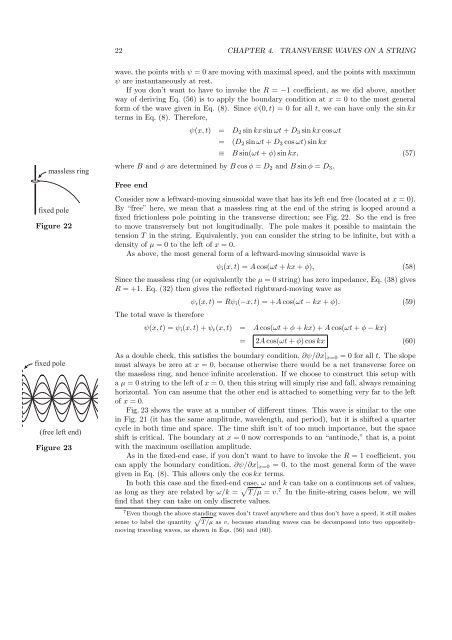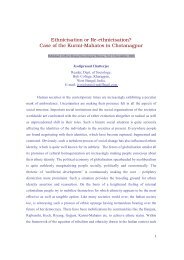Transverse waves on a string - People.fas.harvard.edu
Transverse waves on a string - People.fas.harvard.edu
Transverse waves on a string - People.fas.harvard.edu
Create successful ePaper yourself
Turn your PDF publications into a flip-book with our unique Google optimized e-Paper software.
massless ring<br />
fixed pole<br />
22 CHAPTER 4. TRANSVERSE WAVES ON A STRING<br />
wave, the points with ψ = 0 are moving with maximal speed, and the points with maximum<br />
ψ are instantaneously at rest.<br />
If you d<strong>on</strong>’t want to have to invoke the R = −1 coefficient, as we did above, another<br />
way of deriving Eq. (56) is to apply the boundary c<strong>on</strong>diti<strong>on</strong> at x = 0 to the most general<br />
form of the wave given in Eq. (8). Since ψ(0, t) = 0 for all t, we can have <strong>on</strong>ly the sin kx<br />
terms in Eq. (8). Therefore,<br />
ψ(x, t) = D2 sin kx sin ωt + D3 sin kx cos ωt<br />
= (D2 sin ωt + D3 cos ωt) sin kx<br />
≡ B sin(ωt + φ) sin kx, (57)<br />
where B and φ are determined by B cos φ = D2 and B sin φ = D3.<br />
Free end<br />
C<strong>on</strong>sider now a leftward-moving sinusoidal wave that has its left end free (located at x = 0).<br />
By “free” here, we mean that a massless ring at the end of the <strong>string</strong> is looped around a<br />
fixed fricti<strong>on</strong>less pole pointing in the transverse directi<strong>on</strong>; see Fig. 22. So the end is free<br />
Figure 22 to move transversely but not l<strong>on</strong>gitudinally. The pole makes it possible to maintain the<br />
tensi<strong>on</strong> T in the <strong>string</strong>. Equivalently, you can c<strong>on</strong>sider the <strong>string</strong> to be infinite, but with a<br />
density of µ = 0 to the left of x = 0.<br />
As above, the most general form of a leftward-moving sinusoidal wave is<br />
fixed pole<br />
(free left end)<br />
Figure 23<br />
ψi(x, t) = A cos(ωt + kx + φ), (58)<br />
Since the massless ring (or equivalently the µ = 0 <strong>string</strong>) has zero impedance, Eq. (38) gives<br />
R = +1. Eq. (32) then gives the reflected rightward-moving wave as<br />
The total wave is therefore<br />
ψr(x, t) = Rψi(−x, t) = +A cos(ωt − kx + φ). (59)<br />
ψ(x, t) = ψi(x, t) + ψr(x, t) = A cos(ωt + φ + kx) + A cos(ωt + φ − kx)<br />
= 2A cos(ωt + φ) cos kx (60)<br />
As a double check, this satisfies the boundary c<strong>on</strong>diti<strong>on</strong>, ∂ψ/∂x|x=0 = 0 for all t. The slope<br />
must always be zero at x = 0, because otherwise there would be a net transverse force <strong>on</strong><br />
the massless ring, and hence infinite accelerati<strong>on</strong>. If we choose to c<strong>on</strong>struct this setup with<br />
a µ = 0 <strong>string</strong> to the left of x = 0, then this <strong>string</strong> will simply rise and fall, always remaining<br />
horiz<strong>on</strong>tal. You can assume that the other end is attached to something very far to the left<br />
of x = 0.<br />
Fig. 23 shows the wave at a number of different times. This wave is similar to the <strong>on</strong>e<br />
in Fig. 21 (it has the same amplitude, wavelength, and period), but it is shifted a quarter<br />
cycle in both time and space. The time shift isn’t of too much importance, but the space<br />
shift is critical. The boundary at x = 0 now corresp<strong>on</strong>ds to an “antinode,” that is, a point<br />
with the maximum oscillati<strong>on</strong> amplitude.<br />
As in the fixed-end case, if you d<strong>on</strong>’t want to have to invoke the R = 1 coefficient, you<br />
can apply the boundary c<strong>on</strong>diti<strong>on</strong>, ∂ψ/∂x|x=0 = 0, to the most general form of the wave<br />
given in Eq. (8). This allows <strong>on</strong>ly the cos kx terms.<br />
In both this case and the fixed-end case, ω and k can take <strong>on</strong> a c<strong>on</strong>tinuous set of values,<br />
as l<strong>on</strong>g as they are related by ω/k = T/µ = v. 7 In the finite-<strong>string</strong> cases below, we will<br />
find that they can take <strong>on</strong> <strong>on</strong>ly discrete values.<br />
7Even though the above standing <str<strong>on</strong>g>waves</str<strong>on</strong>g> d<strong>on</strong>’t travel anywhere and thus d<strong>on</strong>’t have a speed, it still makes<br />
sense to label the quantity T/µ as v, because standing <str<strong>on</strong>g>waves</str<strong>on</strong>g> can be decomposed into two oppositelymoving<br />
traveling <str<strong>on</strong>g>waves</str<strong>on</strong>g>, as shown in Eqs. (56) and (60).

















